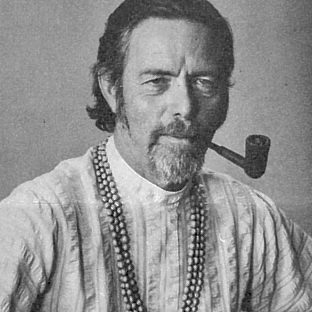
This is the fourth extract from the final chapter of In My Own Way, the autobiography of Alan Watts which came out in 1972 (he died the next year). Interestingly, Watts was inspired in his early teens by Lafcadio Hearn founder of the Lost Japan genre, and like his predecessor he bemoans the industrialisation which is replacing the traits of traditional Japan. He writes too of his visit to Koya-san (The extracts below are taken from pages 351 and 356.)
******************
I have visited Kyoto four times, and will snatch at any opportunity to go there again, despite the plastic fury which which Japanese industrialism is destroying the country. Kyoto is now dominated by a colossal plastic phallus in full erection from the roof of the Station Hotel, and most ‘modern’ buildings look as if they had been put together from sheets of acetate and crimped tin, and the whole industrial project is a frantic success because there are no squares like Kyoto squares. Nevertheless, Kyoto has civic pride in its ancient traditions and monuments, so that there is some resistance to an aesthetic debacle which is perhaps the world’s major illustration of the proverb that the worst is the corruption of the best.
When Oliver Andrews was there with me he remarked that Kyoto somehow reminded him of Hermann Hesse’s Castalia, for, as the greatest international center of Buddhist culture, it is a curiously cosmopolitan city, frequented by pleasantly eccentric people from all over the world. In Kyoto one never feels ‘out of things’ as one can in Miami, Cape Town, Melbourne, or other such places with vast concentrations of people who have nothing very interesting to do. I have my eye on a virtually unused temple in the grounds of Nanzenji – a quiet place by the aquaduct. Will someone please let me have it for a year?
*******************
Unburdened by a Christian upbringing, Gary Snyder has the humorous attitude to religion so characteristic of Zen. We found him in a Japanese-style cottage, close to the Daitokuji monastery in Kyoto, where he was making a twelve-year study of the Zen way of life. He is like a wiry Chinese sage with high cheekbone, twinkling eyes, and a thin beard, and the recipe for his character requires a mixture of Oregon woodsman, seaman, Amerindian shaman, Oriental scholar, San Francisco hippie, and swinging monk, who takes tough discipline with a light heart. He seems to be gently keen about almost everything, and needs no affectation to make himself interesting. He has taken to wife Masa, a beautiful but gutsy Japanese girl from the southern islands, who looks you straight in the eye, does not simper and giggle, gives no mock humility, yet has a quiet naturalness. Their living room is adorned with two large and colorful scrolls bearing those Shingon diagrams of multitudinous Buddha-figures, and so abounds with Buddhist ceremonial tools that Gary called it ‘the safest place in the galaxy’.
After we have taken a communal bath in a huge cauldron over a wood fire, much saké is downed, and apropos of ku, the clear void, Gary suggests that we incorporate the ‘Null and Void Guaranty and Trust Company’ with the slogan, ‘Register your absence with us; you can take it with you!’ Later I had some business cards printed for him to this effect, naming him as the company’s nonrepresenative. I wonder, why is it that we can’t stop laughing at the notion that none of us really exists, and that the walloping concreteness of all the hard facts to be faced is an energetic performance of nothingness?
*********************
For previous extracts from Alan Watts, see Part One here, Part Two here, and Part Three here.
